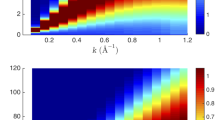Abstract
An exact representation for the density-density response function is presented. This representation is a generalization of the result obtained in the mean field approximation and amounts to replacing the static, effective potential by one which is both wavenumber- and frequency-dependent. This potential possesses both a real and an imaginary part; the latter describes the collisional damping of collective modes. Analyticity and sum rule arguments are used to describe the basic properties of this complex potential. The formalism allows us to write an exact formula for the scattering functionS(k, ω) in which the basic unknown is the collisional damping function. Using a small portion of the recent experimental data on coherent neutron scattering in liquid argon, we are able to calculateS(k, ω) and other quantities of interest and to make comparisons with the rest of the data.
Similar content being viewed by others
References
M. Nelkin and S. Ranganathan,Phys. Rev. 164:222 (1967).
K. S. Singwi, K. Sköld, and M. P. Tosi,Phys. Rev. Lett. 21:881 (1968);Phys. Rev. A 1:454 (1970).
J. Chihara,Progr. Theor. Phys. 41:285 (1969).
M. Nelkin,Phys. Rev. 183:349 (1969).
A. A. Vlasov,Many-Particle Theory and Its Application to Plasma, Gordon and Breach, New York (1961); L. D. Landau,J. Phys. USSR 10:25 (1946).
K. S. Singwi, M. P. Tosi, R. H. Land, and A. Sjölander,Phys. Rev. 176:589 (1968).
T. Schneider, R. Brout, H. Thomas, and J. Feder,Phys. Rev. Lett. 25:1423 (1970); T. Schneider,Phys. Rev. A 3:2145 (1971).
K. Sköld, J. M. Rowe, G. Ostrowski, and P. D. Randolph,Phys. Rev. A 6:1107 (1972).
K. N. Pathak and K. S. Singwi,Phys. Rev. A 2:2427 (1970).
L. P. Kadanoff and P. C. Martin,Ann. Phys. (N.Y.)24:419 (1963).
A. Rahman,Phys. Rev. Lett. 19:420 (1967); inNeutron Inelastic Scattering, International Atomic Energy Agency, Vienna (1968), Vol. 1, p. 561.
L. van Hove,Phys. Rev. 95:249 (1954).
G. Placzek,Phys. Rev. 86:377 (1952).
P. G. de Gennes,Physica 25:825 (1959).
D. Forster, P. C. Martin, and S. Yip,Phys. Rev. 170:155 (1968).
L. P. Kadanoff and G. Baym,Quantum Statistical Mechanics, W. A. Benjamin, New York (1962).
A. A. Abrikosov, L. P. Gor'kov, and I. E. Dzyaloshinski,Quantum Field Theory in Statistical Physics, Prentice-Hall, Englewood Cliffs, N. J. (1963).
D. Forster and P. C. Martin,Phys. Rev. A 2:1575) (1970).
G. F. Mazenko,Phys. Rev. A 3:2121 (1971).
M. Abramowitz and I. A. Stegun,Handbook of Mathematical Functions, Dover, New York (1964), Chapt. 7.
C. D. Andriesse and E. Legrand,Physica 57:191 (1972).
P. A. Egelstaff,An Introduction to the Liquid State, Academic, London (1967), p. 193.
J. K. Percus and G. J. Yevick,Phys. Rev. A 2:1526 (1970); see also J. L. Lebowitz, J. K. Percus, and J. Sykes,Phys. Rev. 188:487 (1969).
R. Zwanzig,Phys. Rev. 156:190 (1967); R. Nossal and R. Zwanzig,Phys. Rev. 157:120 (1967); R. Nossal,Phys. Rev. 166:81 (1968).
P. C. Martin, in1967 Les Houches Lectures, Gordon and Breach, New York (1968), p. 121.
D. Pines and P. Nozieres,The Theory of Quantum Liquids, W. A. Benjamin, New York (1966), Chapter 1.
C. H. Chung and S. Yip,Phys. Rev. 182:323 (1969).
N. K. Ailawadi, A. Rahman, and R. Zwanzig,Phys. Rev. A 4:1616 (1971).
A. Z. Akcasu and E. Daniels,Phys. Rev. A 2:962 (1970).
N. K. Ailawadi,Physica 49:345 (1970).
T. Gaskell,Phys. Chem. Liquids 2:237 (1971).
P. C. Martin and S. Yip,Phys. Rev. 170:151 (1968).
D. Forster, P. C. Martin, and S. Yip,Phys. Rev. 170:160 (1968).
W. C. Kerr,Phys. Rev. 174:316 (1968).
J. Hubbard and J. L. Beeby,J. Phys., C. Ser. 2,2:556 (1969).
R. Brout and P. Carruthers,Lectures on the Many-Electron Problem, Wiley-Interscience, New York (1963), p. 34.
N. N. Bogoliubov,Phys. Abh. SU 6:1, 113, 229 (1962); see also H. Wagner,Z. Physik 195:273 (1966).
N. D. Mermin,Phys. Rev. 171:272 (1968).
A. A. Kugler,Physica 50:155 (1970).
Author information
Authors and Affiliations
Rights and permissions
About this article
Cite this article
Kugler, A.A. Collective modes, damping, and the scattering function in classical liquids. J Stat Phys 8, 107–153 (1973). https://doi.org/10.1007/BF01008535
Received:
Issue Date:
DOI: https://doi.org/10.1007/BF01008535




